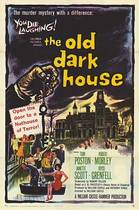Our editor-in-chief Nate Yapp is proud to have contributed to the new book Hidden Horror: A Celebration of 101 Underrated and Overlooked Fright Flicks, edited by Aaron Christensen. Another contributors include Anthony Timpone, B.J. Colangelo, Dave Alexander, Classic-Horror.com's own Robert C. Ring and John W. Bowen. Pick up a copy today from Amazon.com!
Crucible of Terror (1971)
Ostensibly a horror film, Crucible of Terror is more a drama. As a drama, it is adequate, but there is nothing particularly notable about it. There are hundreds of adequate dramas out there, and hundreds of more than adequate ones. So there is no reason that a drama fan is likely to seek out this film. Since it is marketed as horror, and has horror elements, I'll review Crucible of Terror primarily for fans of that genre.
The plot centers on an artist who creates works not to gain fame or fortune, but to record and "preserve the beauty" of the women who are his subject matter. His son, an alcoholic who doesn't seem to do much but drink, steals some of his father's work and commissions it with an art dealer friend. Two primary patrons of the dealer are taken by a life-sized sculpture of a woman - a work of the reclusive artist. It's already been sold, so the dealer talks the alcoholic son into taking him to his dad to try to talk him into selling more of his work. Most of the film takes place at the artist's remote home and grounds, and focuses on the artist's relationships with the women, including his loopy wife, who works as inadvertent comic relief.
Of course, none of this resembles a horror film, but there are horror elements. The opening scene, which is promising, features an anonymous person (it turns out to be the artist) creating a sculpture (which turns out to be the sculpture the dealer's patrons are taken with). Only it's not just any old sculpture-the "frame" is an unconscious or dead women. The shot shows the artist slowly applying plaster, completely covering the woman's head and face, then bronzing her.
There's not much horror after that, except for very brief scenes in which various parties at the artist's complex are dispatched. In all of these, the killer isn't shown, and neither is much else. There is no gore, and no graphic violence. The longest of these murder scenes is probably 20 seconds. And there is no follow through. A short murder scene occurs, we're never shown what happens to the bodies, and no one is overly concerned that anyone is missing. In fact, the most sustained "horror" element is the artist's pursuit of the dealer's significant other. She is frightened of him and there is an effective extended chase sequence that ends with the woman being pursued through an atmospherically spooky abandoned mine (probably the best scene of the film). She reminds the artist of the woman bronzed in the beginning and, despite the fact that he hadn't "executed" any sculptures recently, he has the same plan for her.
There is a bit of a twist ending, but it is executed poorly - the twist scene is short, then in what seems less than one minute, the premise of the twist is explained quickly in the manner of a traditional mystery, complete with "revealed identity" shots of the murders, then bang, it's over.
Again, Crucible of Terror isn't a bad movie, but it's not anything too special either. Horror fans who also like straight dramas might find it a pleasant enough way to kill an hour and a half late at night or on a Sunday afternoon. Also, it's certainly worth watching to any horror fan who tries to see every horror film they can. Otherwise, there are much better films to seek out.








